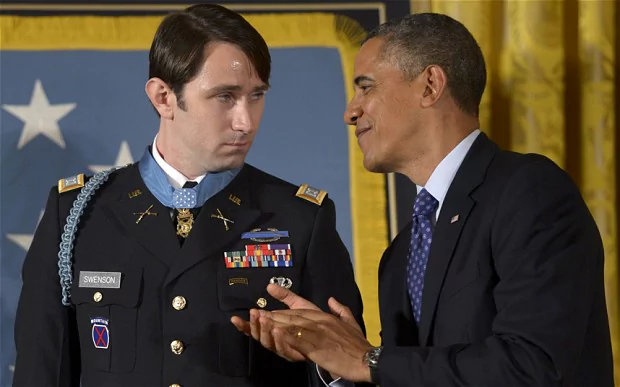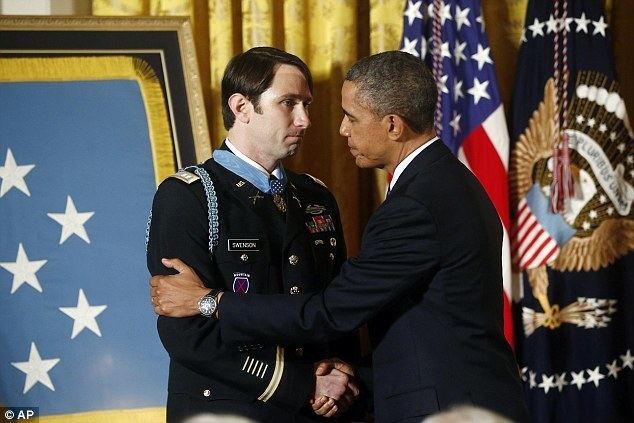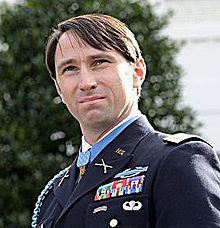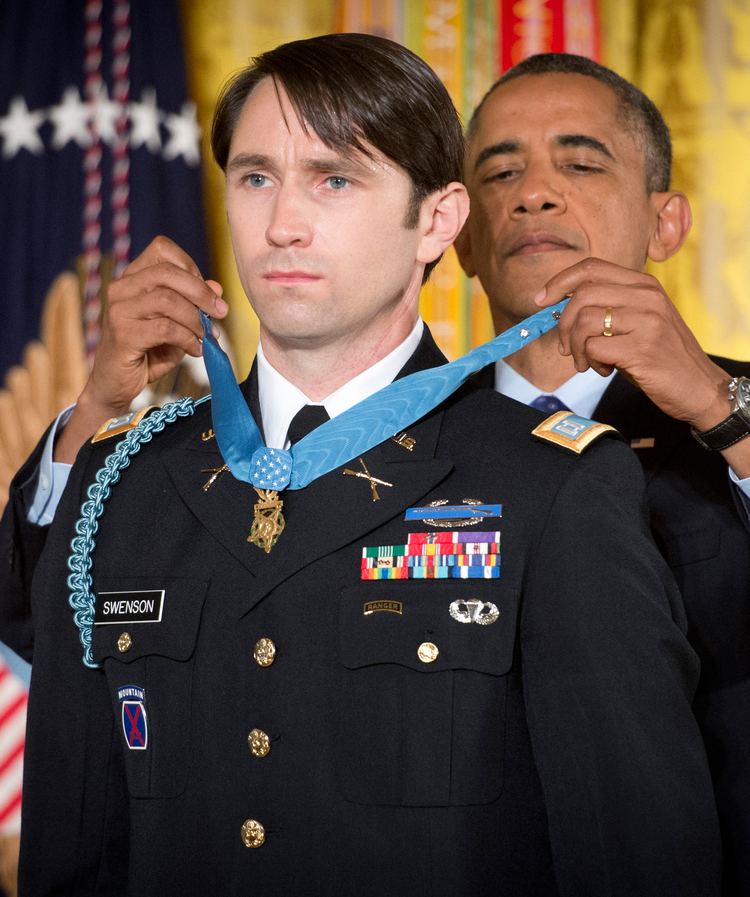Rank Major Name William Swenson | ||
 | ||
Born November 2, 1978 (age 46) ( 1978-11-02 ) Allegiance United States of America Years of service 2002–20112014 – present Battles/wars Iraq WarWar in AfghanistanBattle of Ganjgal Similar People Dakota Meyer, Leroy Petry, Salvatore Giunta, Kyle Carpenter, Kyle J White | ||
Army captain william d swenson receives medal of honor ceremony
William D. Swenson (born November 2, 1978) is a Major in the United States Army who was awarded the Medal of Honor in a ceremony on October 15, 2013. He was the sixth living recipient in the War on Terror. As of March 2016, Swenson and Senior Chief Petty Officer Edward Byers are the only Medal of Honor recipients still on active duty.
Contents
- Army captain william d swenson receives medal of honor ceremony
- William d swenson former army captain awarded medal of honor
- Early life and education
- Career
- Medal of Honor action
- Medal of Honor award
- Hall of Heroes induction ceremony
- Medal of Honor citation
- Awards and decorations
- Personal life
- References

William d swenson former army captain awarded medal of honor
Early life and education

Swenson graduated from Seattle University with a Bachelor of Science degree in political science.
Career

He commissioned from Officer Candidate School as a United States Army infantry officer in September 2002. His military education, mostly at Fort Benning, includes Basic and Advanced Infantry Officer Courses, Ranger School, and Airborne School. He has deployed three times in the War on Terror, once to Iraq and twice to Afghanistan. He has been awarded the Bronze Star Medal (with two oak leaf clusters), the Purple Heart, and the Combat Infantryman Badge. At the time of the Battle of Ganjgal, Swenson was a Captain in 3rd Brigade Combat Team, 10th Mountain Division, detailed as an Embedded Trainer for the Afghan Border Police.

He left the Army in February 2011 and lived in Seattle, Washington. In October 2013, Swenson requested to return to active duty. On March 14, 2014, he was accepted back onto active duty and serving as a plans officer at the I Corps headquarters. In 2015, along with Representative Hunter and others, Swenson advocated on behalf of Major Mathew Golsteyn, who had his Silver Star Medal revoked following an investigation that led to no charges. In March 2016, Swenson was assigned to United States Army South.
Medal of Honor action
On September 8, 2009, Swenson was part of an operation to connect the Afghan government with native elders in the Ganjgal Valley in Eastern Kunar Province in Afghanistan, near the Pakistan border.
According to the U.S. Army's detailed Official Narrative, the coalition force's 106-man column entered the valley and was ambushed at about 6 a.m. by as many as 60 insurgent fighters who soon surrounded the column on three sides, situated on terraced high ground. Within an hour, communication to the front of the column, including four U.S. servicemen, was lost. Meanwhile, Captain Swenson, who initially was positioned toward the rear of the column, called for air support, and with two comrades crossed 50 meters of open space under direct enemy fire to administer life-extending first aid to his severely wounded sergeant. When the column was surrounded by enemy fighters that advanced within 50 meters, Swenson responded to Taliban demands for surrender by throwing a hand grenade, an act of defiance that rallied his comrades to repel the enemy advance.
Swenson and comrades moved his sergeant and other wounded to a helicopter for medical evacuation before returning to the enemy's "kill zone" for at least two more trips in an unarmored vehicle to evacuate additional wounded. Returning even more deeply through the kill zone toward the location of the head of column in search of the four U.S. servicemen, Swenson's party first rescued and recovered several Afghan National Security Force wounded and dead. Finally, Swenson and a small contingent recovered the four fallen U.S. servicemen who had been discovered by a search and rescue aircraft at noon. The 6–7 hour firefight caused 15 coalition deaths, including the four U.S. servicemen; also, Swenson's sergeant, Kenneth Westbrook, died of his wounds after returning from Afghanistan. Swenson's actions are believed to have directly contributed to saving more than a dozen Afghan lives.
Medal of Honor award
Swenson received the Medal of Honor on October 15, 2013. He was nominated for his actions as an Embedded Trainer in the Battle of Ganjgal near the Afghanistan-Pakistan border on September 8, 2009. He is reported to have repeatedly entered the "kill zone" in order to rescue wounded American and Afghan soldiers, much like his fellow serviceman Dakota Meyer who was awarded the Medal of Honor in 2011. Swenson became the first living officer to receive the Medal of Honor since Vietnam.
Being recommended for the Medal of Honor in December 2009 by a battalion commander, the paperwork was lost, causing a significant delay in the nomination process. Some believe that Swenson was being punished for loudly criticizing his senior officers (for not sending fire support) in an after-action investigation into the battle. His case was reopened in 2011 at the urging of Marine Corps General John R. Allen. Dakota Meyer strongly advocated for Swenson's Medal of Honor in his book, Into the Fire: A Firsthand Account of the Most Extraordinary Battle in the Afghan War, writing that if it weren't for Swenson, he (Meyer) would not be alive today. In May 2014, the Department of Defense reported that based on an investigation, Swenson's Medal of Honor recommendation was lost in the Army's Email system. In February 2015, it was revealed that in the period prior to Swenson receiving the Medal of Honor, in 2013, that the Criminal Investigation Command began an investigation on Swenson due to comments made on Amazon.com by Major Mathew Golsteyn in 2011.
Hall of Heroes induction ceremony
Following the Medal of Honor presentation at the White House, on October 16, 2013, Swenson was inducted into the Pentagon Hall of Heroes. The ceremony was officiated by Chuck Hagel, the Secretary of Defense. Hagel was assisted by the Secretary of the Army John M. McHugh, Army Chief of Staff General Ray Odierno and the Sergeant Major of the Army, Raymond F. Chandler. During the ceremony, Chuck Hagel apologized to Swenson for the mishandling of his award nomination, which had been delayed for 19 months because of what officials called a bureaucratic oversight. McHugh later told the standing room only audience that the Army would implement a new process providing greater oversight to "ensure that no future award packet is lost along the way or paperwork misplaced or somehow forgotten in the fog of war." The new directive, McHugh stated, required Medal of Honor nominations be sent immediately to Army Human Resources Command, known as HRC. "As soon as an honors packet is created at battalion level, we will have immediate visibility at Army headquarters," he told the audience.
Referencing allegations that Swenson's award had been intentionally lost as a result of his criticizing leadership actions after the battle, Odierno said that "Swenson's strength of character was undeniable. Even after the battle, Will was not afraid to point out deficiencies in the operation that caused difficulties in obtaining the appropriate and timely support necessary. He recognized the importance of assessing performance, and had the character to stick to his convictions."
Following the presentation of his framed citation and the personal Medal of Honor flag, Swenson spoke briefly.
"I look at this crowd and I see the strength of a nation and I see the strength of a fighting force, one that I fought proudly with. I look at my fellow Marines, Army, Navy and Air Force, a team that I fought side-by-side with as brothers. It's the proudest moment of my life and I'm honored and privileged to know these men."
Medal of Honor citation
Medal of Honor Official Citation reads:
For conspicuous gallantry and intrepidity at the risk of his life above and beyond the call of duty:
Captain William D. Swenson distinguished himself by acts of gallantry and intrepidity at the risk of his life above and beyond the call of duty while serving as embedded advisor to the Afghan National Border Police, Task Force Phoenix, Combined Security Transition Command-Afghanistan in support of 1st Battalion, 32nd Infantry Regiment, 3rd Brigade Combat Team, 10th Mountain Division, during combat operations against an armed enemy in Kunar Province, Afghanistan on September 8, 2009. On that morning, more than 60 well-armed, well-positioned enemy fighters ambushed Captain Swenson's combat team as it moved on foot into the village of Ganjgal for a meeting with village elders. As the enemy unleashed a barrage of rocket-propelled grenade, mortar and machine gun fire, Captain Swenson immediately returned fire and coordinated and directed the response of his Afghan Border Police, while simultaneously calling in suppressive artillery fire and aviation support. After the enemy effectively flanked Coalition Forces, Captain Swenson repeatedly called for smoke to cover the withdrawal of the forward elements. Surrounded on three sides by enemy forces inflicting effective and accurate fire, Captain Swenson coordinated air assets, indirect fire support and medical evacuation helicopter support to allow for the evacuation of the wounded. Captain Swenson ignored enemy radio transmissions demanding surrender and maneuvered uncovered to render medical aid to a wounded fellow soldier. Captain Swenson stopped administering aid long enough to throw a grenade at approaching enemy forces, before assisting with moving the soldier for air evacuation. With complete disregard for his own safety, Captain Swenson unhesitatingly led a team in an unarmored vehicle into the kill zone, exposing himself to enemy fire on at least two occasions, to recover the wounded and search for four missing comrades. After using aviation support to mark locations of fallen and wounded comrades, it became clear that ground recovery of the fallen was required due to heavy enemy fire on helicopter landing zones. Captain Swenson’s team returned to the kill zone another time in a Humvee. Captain Swenson voluntarily exited the vehicle, exposing himself to enemy fire, to locate and recover three fallen Marines and one fallen Navy corpsman. His exceptional leadership and stout resistance against the enemy during six hours of continuous fighting rallied his teammates and effectively disrupted the enemy's assault. Captain William D. Swenson's extraordinary heroism and selflessness above and beyond the call of duty are in keeping with the highest traditions of military service and reflect great credit upon himself, Task Force Phoenix, 1st Battalion, 32nd Infantry Regiment, 3rd Brigade Combat Team, 10th Mountain Division and the United States Army.
Awards and decorations
The U.S. Army lists Swenson’s awards and decorations as including:
Swenson also has five Overseas Service Bars.
Personal life
In 2016, Swenson was the target of "419" romance scams and frequently had fraudulent pages posted on Facebook using his name and photograph.
